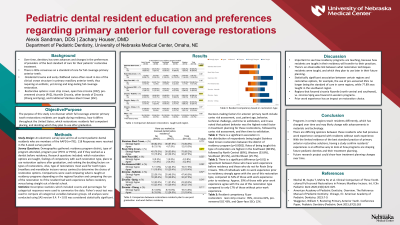Restorative
319 - Pediatric Resident Education and Preferences Regarding Primary Anterior Full-coverage Restorations

.jpg)
Alexis Sandman, DDS
Pediatric Dental Resident
University of Nebraska Medical Center
UNMC Pediatric Dentistry
Lincoln, Nebraska, United States- ZH
Zachary L. Houser, DMD
Program Director
University of Nebraska Medical Center
Omaha, Nebraska, United States
Presenting Author(s)
Program Director(s)
Purpose: The purpose of this study was to discover via survey which full coverage anterior primary tooth restorations residents are taught during residency and secondarily to determine which full coverage anterior restorations residents prefer. The goal was to identify with the survey how the treatment planning of anterior primary teeth is currently changing.
Methods: An email survey was sent to AAPD member pediatric dental residents and asked about the district, type of program, and year of residency they are in. Research questions included restorations taught, feelings of competency, plans to use restoration types after graduation, and ranking decision-making factors. Descriptive statistics summarized data and Fisher’s exact test was used to compare categorical variables.
Results: Results included that strip crowns were taught most, whereas open-face SSCs were not taught in 88% of programs. The top factors in deciding which restoration type are patient behavior, caries risk, and time to exfoliation, and the ranking of options of restoration per tooth type were also found. More residents plan to use Zirconia-NuSmile after graduation than pre-veneered SSCs. Comparisons showed SSCs being most common in the southwest, whereas Zirconia NuSmiles were most common in the Southwest and North Central regions. In addition, it was found that residents with prior work experience favored strip crowns less than residents without work experience (76% vs 54%).
Conclusion: Overall, we were able to observe more information about education, decision-making, and competency regarding resident opinions on primary anterior restorations.
Identify Supporting Agency and Grant Number:

.jpg)